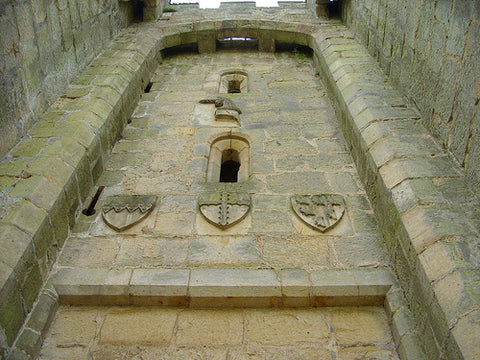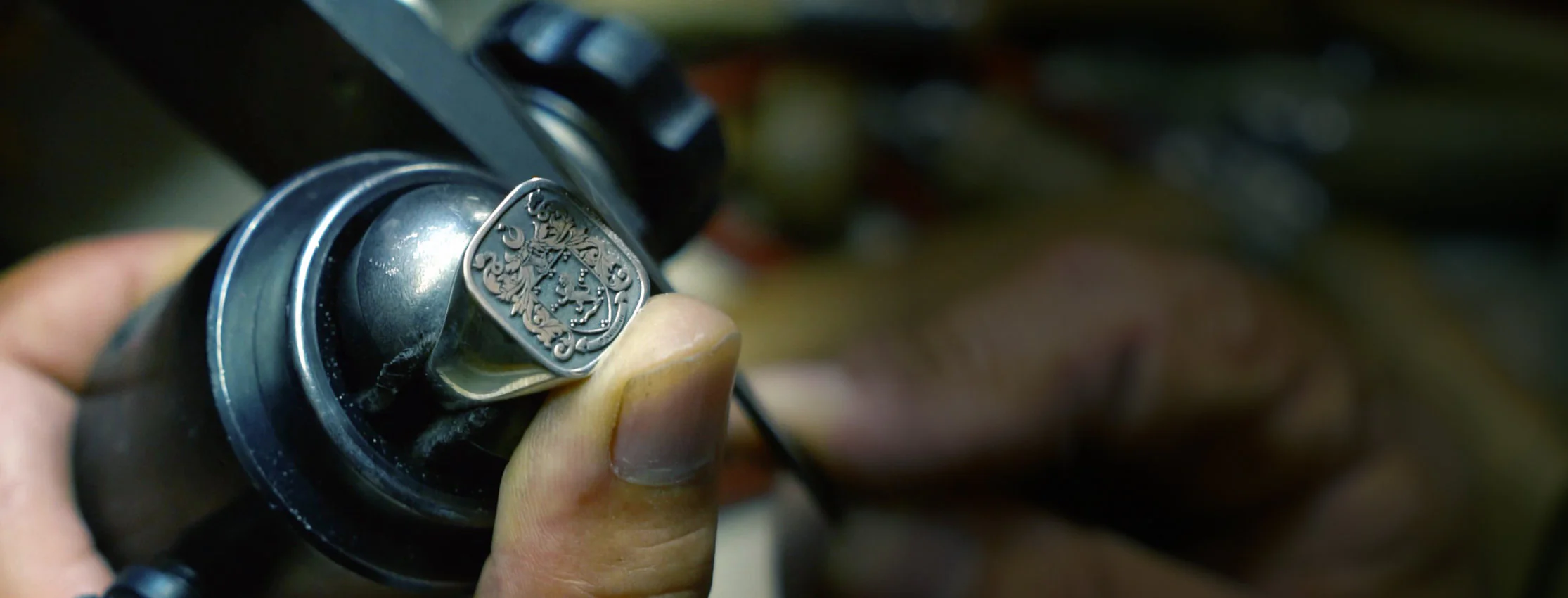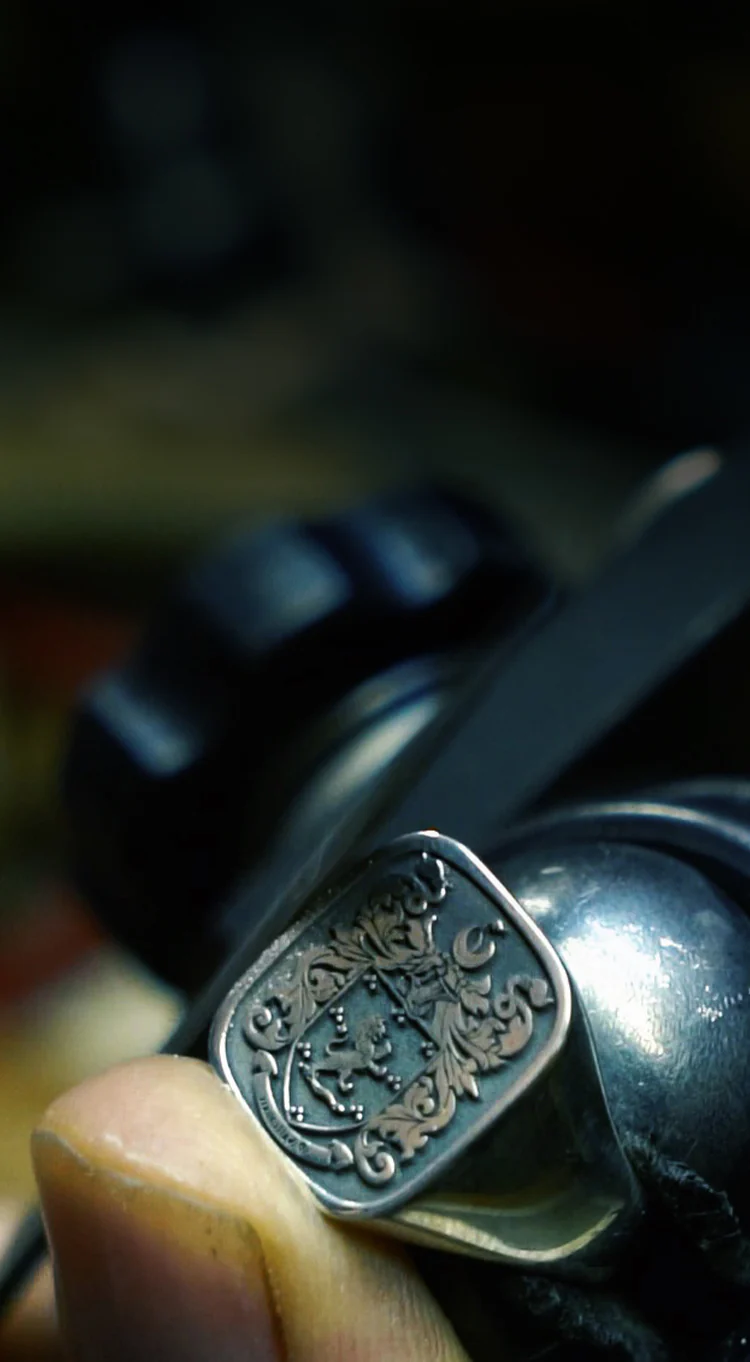

The origins of heraldry

Mankind has created numerous systems of signs since the dawn of time for communication and assimilation of information. Today it is difficult to imagine past and present civilizations without ancient hieroglyphics, letters, numbers, allegorical figures, road signs, morse code and other sets of unified symbols. Coats of Arms, which first appeared in the Middle Ages and remain in use to this day, also belong in this list. Their difference, compared to other signs, is that they have more than a practical significance. Coats of Arms symbols made meaningful the pursuits, ideas, ambitions, and even specific events of society. Victor Hugo once wrote, “ To the person who can read heraldry- the coat of arms is algebra; the coat of arms is a language. The entire history of the second half of the Middle Ages is written in heraldry, the same as the history of the first half is written in the symbolism of the Roman Church”
Coats of Arms were so widespread during the late Middle Ages and modern times that heraldry resonates in nearly all spheres of public life: politics, arts, the military, law, and literature. Noblemen displayed coats of arms on shields they carried into battle, as well as on their clothes at their manor estates. Women sewed dresses decorated in them and palace servants wore heraldic liveries. Coats of arms appeared on flags, seals and signets, coins and medals for special occasions. They served as décor on castles and palaces of sovereigns, and churches, town halls, household necessities, carriages, books, and tombstones of the nobility and of townspeople. Writers created odes and epigrams for coats of arms, and often legends about their exceptional origins. Life was such that a coat of arms followed an individual all the way to their final journey.
The subject of Heraldry has been shrouded in mystery partly due to obfuscation on the part of writers on the subject and partly due to it’s origin in the language of heraldry, which is a language not used in the vernacular and created solely for the purpose of describing Blazon’s or descriptions of Arms. The language of Heraldry was formed from a combination of Old English and Norman French and has a beauty and romance all of it’s own, the fact that it is one of the few languages ever created that is not spoken only adds to it’s beauty and adds an air of romance to the subject of Heraldry.
Heraldry can be described as the shorthand of History, while this is a neat and tidy description it does not properly describe the broad strokes of medieval life contained within the art of heraldry. When we speak of Heraldry we usually mean coats of arms, crests, etc. and not merely the ceremonial or other functions of a herald. Originally the word “Heraldry” meant the science or duties of a herald; only later did the word come to also mean the terms and descriptions of the art which the herald had to administer. There were an abundance of coats of arms long before there were any recognized heralds, and the word used to describe arms, their meaning and use was “Armory”, this term is rarely used any more in relation to heraldry.
 It is very important to get these definitions clear at the outset, and so although we shall deal at proper length with the constituent parts of the coat of arms later, I would like to remove one misconception now. People often say that they have a crest, when they mean that they have a coat of arms, this is strictly incorrect as the crest is the part of the coat of arms that is above the helmet and a coat of arms is the correct term for the whole armorial achievement. This includes, shield, helmet, crest, mantling, and sometimes supporters. The essential part is the shield, without which there can be no coat of arms, the crest is merely an addition made much later. The term “Coat of Arms” is derived from the practice of covering over the armor of knights in the Middle Ages with a coat of linen or in some cases silk. The covering was used to protect the armor from rust and dirt and also to protect the wearer from the effects of the sun shining on the steel. On these covers the arms of the bearer were embroidered, hence the term “ Coat of Arms”.
It is very important to get these definitions clear at the outset, and so although we shall deal at proper length with the constituent parts of the coat of arms later, I would like to remove one misconception now. People often say that they have a crest, when they mean that they have a coat of arms, this is strictly incorrect as the crest is the part of the coat of arms that is above the helmet and a coat of arms is the correct term for the whole armorial achievement. This includes, shield, helmet, crest, mantling, and sometimes supporters. The essential part is the shield, without which there can be no coat of arms, the crest is merely an addition made much later. The term “Coat of Arms” is derived from the practice of covering over the armor of knights in the Middle Ages with a coat of linen or in some cases silk. The covering was used to protect the armor from rust and dirt and also to protect the wearer from the effects of the sun shining on the steel. On these covers the arms of the bearer were embroidered, hence the term “ Coat of Arms”. Heraldry is essentially medieval in origin and is associated with all of the images we conjure up when the Middle Ages come to mind. Knights in shining armor, castles, lovely ladies, princes and princesses, damsels in distress, tournaments, dragons, giants, all the apparatus of old romance, yes it is with things such as these that heraldry is linked. It is one of the traditions that has survived to this day. At Canterbury Cathedral in London can be seen the shield of the Black Prince, close by is the perfect medieval Bodiam Castle, with the arms of Bodiam, Wardedieux, and Dalyngrigge families over the great gateway.
An early example of this type of evidence is an illuminated miniature from the Luttrell Psalter circa 1340 which shows the figures of Sir Geoffrey Luttrell with his wife and daughter-in-law. Sir Geoffrey’s arms are shown in several places in the drawing, these arms being described as ” azure a bend between six martlets argent” . Both of the ladies show the Luttrell arms on their gowns impaling ( meaning that the shield or coat of arms is divided down the middle with one coat of arms on the right side and the second on the left side) the arms of their own father’s families.
The Luttrell psalter, image above, made for Sir Geoffrey Luttrell of Irnham in Lincolnshire. The image shows Sir Geoffrey being handed his helmet by his wife, Agnes Sutton, who is waring a gown showing the arms of Luttrell impaling Sutton's, and his shield by his daughter-in-law, Beatrice le Scrope who wears a surcote of the Luttrell arms impaling Scrope of Masham. Agnes died in 1340, and Beatrice married Geoffrey's son Andrew in 1320, so the manuscript can probably be dated between these events.

Luttrell Psalter
Another early example of evidence of documented heraldry is in the great east window of Gloucester Cathedral, image below, which is described as the earliest war memorial in England. It was installed by one of the warriors of Agincourt and contains at the base the coats of arms of some of the fighters who were there in 1415.
Consequently when we say that the use of coats of arms arose in Europe in the 12th century we have to depend on indirect evidence, which fortunately is available. The Bayeux Tapestry is a great aid in this respect. The Tapestry was created in the 11th century, and it shows the process of the Norman Conquest from the period of the latter part of Edward the Confessor’s life until the end of the Battle of Hastings. Contained in this tapestry is valuable contemporary evidence as to the styles of clothes and arms that were used in the period 1060-1066.
French legend maintained the tapestry was commissioned and created by Queen Matilda, William the Conqueror’s wife, and her Ladies-in-waiting. Indeed, in France it is occasionally known as “La Tapisserie de la Reine Mathilde” (Tapestry of Queen Matilda). However, scholarly analysis in the 20th century shows it probably was commissioned by William’s half brother, Bishop Odo. The reasons for the Odo commission theory include: 1) three of the bishop’s followers mentioned in Domesday Book appear on the tapestry; 2) it was found in Bayeux Cathedral, built by Odo; and 3) it may have been commissioned at the same time as the cathedral’s construction in the 1070s, possibly completed by 1077 in time for display on the cathedral’s dedication.

We have only to compare the designs in the Bayeux Tapestry with those seen in the Luttrell Psalter to see how much over the course of 300 years the quality of the artwork progressed from the crude Norman and Saxon drawings. Fortunately we are able to bridge the gap with earlier illustrations prior to 1340. There is an interesting enamel which has the portrait of Geoffrey Plantagenet, Count of Anjou, the son-in-law of Henry 1.This shows the arms used on his shield that were given to him by Henry 1 on the occasion of his marriage in 1127. Four Gold Lions appear on the shield , and as Geoffrey was the ancestor in the male line of the Plantagenets who were the first kings of England to use coats of arms these gold lions may in a sense be the forerunners of the lions on the royal arms used to this day. This enamel dates from 1136 and it is the earliest example of an heraldic shield in existence.
Next to the enamel we have the evidence of the seals, which in the period from 1135 to 1155 show the use of heraldic designs. Seals were used not only in the Middle ages but much earlier to authenticate documents for those that could not read. In ages when few were literate there had to be some sign that men could easily understand to show that the person who was supposed to have produced the document had actually done so. The seal which was attached to the document had to have something that identified the user of the seal. There is evidence of the use of seals as early as the Babylonian and Assyrian empires, and the practice was brought to Europe long before writing became commonplace. Thus though we often speak of King John having signed the Magna Carta in 1215, what we really mean is that he sealed it, for it is his seal and not his signature which is shown on the document. Apart from the enamels I quoted earlier from 1136 the seals of arms constitute our earliest physical evidence of the appearance of coats of arms.
What do we mean when we say that a certain design is heraldic and another is not, and that symbols have been used on shields for thousands of years without being heraldic? The answer is that for a design to be heraldic it must be hereditary. The designs used by the warriors of the Bayeux Tapestry, such as Count Eustace of Boulogne, are not the same as those of his descendants, from this we can infer that the Bayeux design was not intended to be hereditary.
The essence of Heraldry is that the symbols used become hereditary and are passed down in families from father to son. This is what differentiates them from the symbols used on the shields of warriors in previous ages and in lands other than Western Europe. Illustrations of Greek warriors depict the drawings and illustrations on their shields, and anybody who has suffered from construing the descriptions of Aeneas’ shield in Virgil or Achilles’ shield in Homer will know that those shields were also decorated. We know that the use of heraldic symbols did not prevail amongst the Greeks and Romans. The Romans had an unusual method of showing their ancestry. They would place wax, and later more permanent images, in the halls of their homes, these images being representations of their ancestors who had held public office. Among the Greeks there was a similar lack of use of hereditary symbols, although there is some evidence to suggest that some primitive form of Heraldry prevailed among the great families of the 5th century B.C. in ancient Athens.
In all ages and countries of which we have any record there have been symbols used in war and in peace, but these are not the same as those which we call heraldic simply because they did not become permanent or hereditary. It is only in Western Europe that we find heraldic illustrations at the same time, in England, Scotland, France, Spain, Germany, Italy, Holland and Belgium, appearing at about the same period (1135 – 1155), and continuing to spread. The common development does not necessarily mean that they are the product of a single mind, rather they most probably originated from a utilitarian motive. For some time after the Norman Conquest armor continued to be mostly of chain mail and was fairly light. The death of leaders, such as King Harold at the Battle of Hastings (1066), from an arrow piercing his eye when unprotected by any face armor, or later (1199) the death of Richard I from an arrow piercing his shoulder, led attention to be given to the problem of more body protection for the knights.
Very soon after, as can be seen from illustrations of the period, the helmet, instead of being open, closed over the face and gave additional protection in battle. At the same time the body was encased in solid plate armor which replaced the more flimsy chain mail. Thus the knight received more protection, but at the same time became less recognizable to friends and foe alike. Consequently it is probable that the use of coat armor developed out of the necessity of knowing one’s leaders in battle. It is a fact that the 12th century which saw the knight clad in armor saw also the development of coats of arms on his surcoat, his shield, his lance and banner.
Heraldry was not only confined to Western Europe but to those sections which were feudal in origin and had close links to the Catholic Church. Poland has Heraldry because she is linked with the West through the fact that alone of the Slavic nations she is Catholic, and has thus received western civilization. In Ireland, Wales and the Highlands of Scotland, Heraldry has been imitative, and the arms of ancient Celtic families are found to be much more recent than the pedigrees of these families would seem to warrant. The reason is that the arms have been adopted in the later Middle Ages in imitation of those of non-Celtic families which belonged to the Western feudal tradition.
There is one important exception to the rule laid down above. In Japan for many ages the mon has been used, which corresponds to the crest (part of the coat of arms in Europe) and is the family symbol of the Japanese people. The Mon is depicted in two tinctures, one colour and one metal, with one of the tinctures serving as the field. It is normally constructed of a primary charge group, on occasion surrounded by an annulet or other enclosure. The mon was used as both a badge and a device and represented either a person or (more commonly) a dynastic house. If defined strictly by western heraldic standards, a mon would be considered closer to a badge than a device.
In Japan, the long feudal period during which the Mikado was kept a prisoner under the rule of the Shoguns all the conditions flourished which in Europe made the Medieval period so picturesque and so uncomfortable for peaceful persons. The Japanese knights were certainly no less venturesome than their European counterparts and their ladies no less beautiful, added to which the Japanese had a love of fighting verging on the insane.
Back to menu
Shop Our Products


-
-
Bring Your Idea to Life
Start with a personalized consultation, sharing your vision and preferences with our expert design team. With over 20 years experience we have the knowledge and craftsmanship to create a unique piece of jewelry that will be cherished for generations to come.







